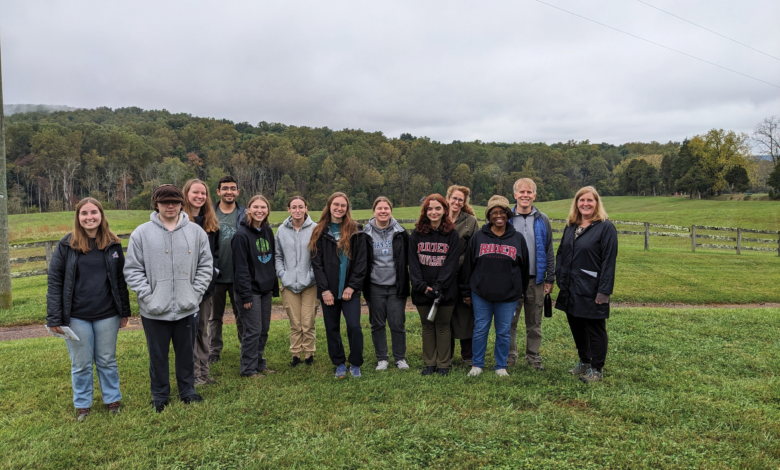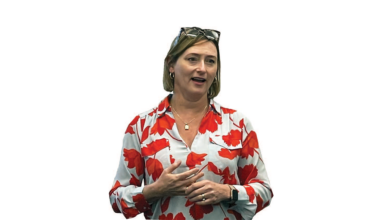
‘What sets him apart’: Druckenbrod’s journey to Rider
By Caroline Haviland
Within his office on the third floor of the Science and Technology Center, which feels more like a walk-in closet, professor Daniel Druckenbrod surrounds himself with his environmental studies: a painting above his desk showing the seasonal progression of different native trees and his computer screen monitoring the forecast for a windy February morning.
From an outside perspective, some might say work is his life, but studying the environment captivated Druckenbrod long before it became his job.
Growing up in rural Pennsylvania instilled in Druckenbrod, a professor of earth and chemical sciences, a lifelong interest in observing nature from a young age.
“I always enjoyed being outdoors, playing in the woods and going on hikes,” said Druckenbrod. “It led me to recognize that a lot of the explanation for why our environment looks the way it does has to do with our history of human use of the environment, which led me to ask myself scientific questions.”
He brought this curiosity to the University of Notre Dame as an undergraduate in biological sciences, where he conducted research on wetlands in Wisconsin. Afterward, he received a master’s degree and Ph.D. in environmental sciences from the University of Virginia.
Following his education, Druckenbrod became a research associate in the environmental sciences division of Oak Ridge National Laboratory in Oak Ridge, Tennessee, one of the secret cities where atomic weapons were developed during World War II.
The production of these weapons in the 1940s led to serious environmental pollution, and the laboratory remains a preeminent research institution for environmental scientists.
After working at Sweet Briar College and Longwood University, Druckenbrod came to Rider in 2009.
“I was drawn to Rider because we have an environmental sciences major, plus I had the opportunity to come here and work with students in small class settings,” said Druckenbrod. “Especially in an environment where I can continue to do my research and do research with students is really an appeal.”
A hands-on experience
Throughout his time at Rider, Druckenbrod has prioritized hands-on learning in both nature and the classroom.
He recently arranged a class trip to James Madison’s Montepelier plantation to practice research skills on a newly discovered burial ground of enslaved people. The surrounding land of these well-known grounds have been studied less, however, which motivates Druckenbrod to learn more.
“Studying these sites that are important to U.S. history, like James Madison’s Montpelier and Washington’s Mount Vernon, has been a very fortunate experience for me,” said Druckenbrod. “But the landscapes around them have not been studied, which is the next layer. They tell the complete story for not only the environment but for those who worked on the environment.”
Through a partnership with facilities and the Office of Sustainability Management, Druckenbrod has been able to create walking trails to let his students study the woods on Rider’s campus. This allows him to show his classes tree rings, his main source of research since they display a tree’s age and how an environment has changed over time.
His environmental science students also get the opportunity in his lab to study tree rings from the Himalayas through a grant with Columbia University, where they get to reanalyze tree rings from thousands of years ago.
“Hands-on experience is great for students because it’s really the best way to learn whether you’re in a geology class or getting to do tree ring research,” said Druckenbrod. “There is nothing better than getting the experience and learning it for yourself.”
A ‘down to earth kind of guy’
Reed Schwimmer, a professor of earth and chemical sciences, has worked with Druckenbrod at Rider since his arrival in 2009. The pair, as well as the rest of the department, has worked closely together.
“He’s really good at involving students in his research, and I can’t overemphasize how important that is. I know the students enjoy it,” said Schwimmer. “That’s what sets him apart from other professors on campus.”
Last semester, the marine science and geology major fell victim to major departmental cuts across the university. The Department of Earth and Chemical Sciences had to reconstitute their courses and add new concentrations to their remaining majors.
Druckenbrod helped spearhead the vision of providing an environmental science focus. His passion for the job overlaps into his personal life, as Druckenbrod’s spare time is filled with simple joys like still going on hikes to admire the nature around him.
Schwimmer summarized Druckenbrod: “He is just a very down to earth kind of guy.”


